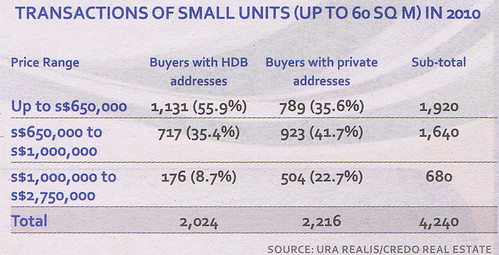Small apartment or condominium units - including the smaller "shoeboxes" - have captured the attention of the residential property market here in recent years with their popularity among buyers and the high per-square-foot prices that they are able to command.
This trend towards small units is also occurring in major cities such as London, Tokyo and Hong Kong. It is part of an evolutionary process where the rise in real estate values is accompanied by demographic and lifestyle changes.
There are now more singles and couples without children, people who spend less time at home and those who dine out more often, etc. And the trend is fast gaining momentum.
In 1996, there were only 114 transactions in Singapore involving small units of up to 60 sq m, based on caveats lodged, representing only 0.8% of the total number of private non-landed residential transactions.
The bull market in 2007 saw small units marketed in greater numbers, with 1,669 sold, accounting for 5.1% of non-landed transactions.
By last year, the number of sales involving such units had increased substantially to 4,240, or 13.3% of non-landed transactions.
This trend has continued into this year, with the first quarter seeing 1,121 small units sold, accounting for 19.3% of non-landed sales.
Since last year, transactions have involved units as small as 24 sq m, while more than a quarter of those within the 60 sq m threshold were between 30 and 40 sq m.
Absolute prices have varied from $350,000 for a secondary market unit to $2.72 million for a high-end one at Scotts Square. Unit rates also varied widely, with suburban units fetching around $800 psf, while the Scotts Square transaction was at $4,358 psf.
Purchasers of Small Units
Small units are only suitable for occupation by singles or couples without children. While some singles or couples have bought with occupation in mind, most of the buyers of small units have been investors. What is notable is that many HDB residents have been buying small units.
In 2007, of the 1,669 small units transacted, 35.9% of the buyers had HDB addresses. This proportion increased to 47.7% last year and 49.9% in the first quarter of this year.
The table shows that about 56% of small unit buyers with HDB addresses purchased at a price of $650,000 or less.

Another 35% or so bought their units at between $650,000 and $1 million, while less than 9% purchased at beyond $1 million.
Buyers of small units with private addresses, on the other hand, were more active in the mid- to upper price ranges, with nearly two-thirds buying at $650,000 and above.
This suggests that buyers with private addresses are less constrained by their budgets compared to those with HDB addresses.
As most buyers with HDB addresses have families, it is unlikely that they bought the small units for upgrading. This shows a growing trend among HDB households to invest for rental returns.
But due to budget constraints, they are able to afford only the smaller units with lower absolute prices. Anecdotally, we have heard of that ideal financial or retirement arrangement where one continues to live in an HDB flat while having a private property to provide rental income.
Examine the Fundamentals
Did the buyers of small units, especially those who are more budget-constrained, buy because they genuinely assessed that the product would fetch a good return or were they drawn by the affordable absolute price per se?
With an increasing supply of small units, will there be sufficient rental or owner-occupier demand? If the size of the unit is too small, would it be practical for living? If a development has a high proportion of small units, what will be the impact of the increased density on the living environment and traffic? These are issues that buyers of small units should ponder over.
Small units are not sure winners when it comes to leasing and will be subject to competition from others on the market.
Only those with strong attributes will attract tenants readily and at good rental. Generally, these would be centrally located, within or near the city or in proximity to amenities and transport.
As the trend towards small units continues, buyers will be presented with even more investment opportunities but they have to consider the fundamentals thoroughly in order to make better buying decisions.
Source: TODAY online
In other words, not all small units are built equal, despite the common perception of affordability of such units. So caveat emptor!
.

No comments:
Post a Comment